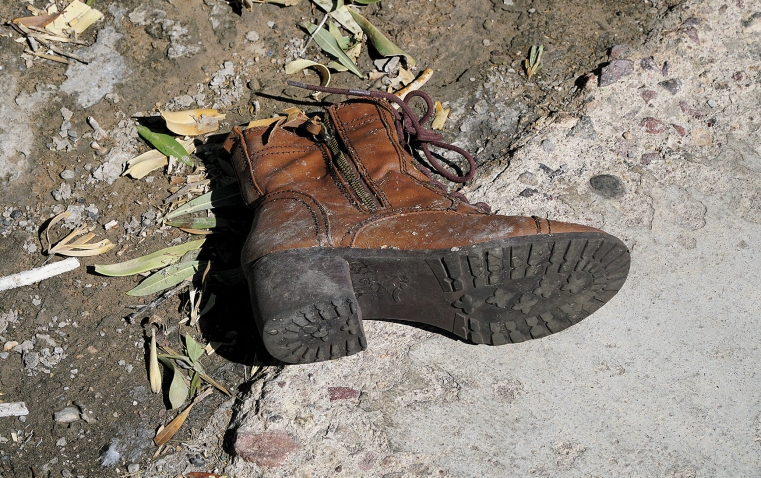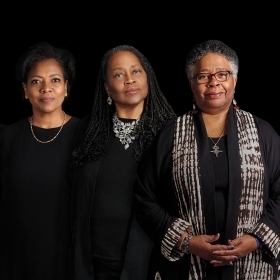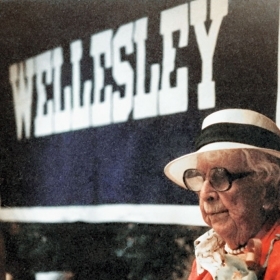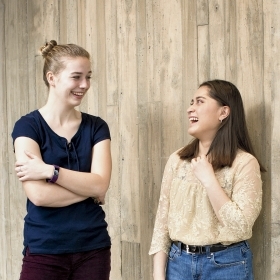A lone boot near the grounds of the country music festival in Las Vegas, Oct. 5, 2017
Photo by Gettyimages/Icon Sportswire
I
’ll never forget the 6-year-old boy in the superhero shirt. He was running around the hospital waiting room holding up a cell phone like a trophy, and he stopped a few feet away from where I was sitting. I smiled at him. He looked at me and then looked down and started tapping the phone.
That’s when the shots rang out: Bang-bang-bang.
Everyone in the waiting room at Sunrise Hospital in Las Vegas froze. It was 2 p.m. on Monday, Oct. 2, 2017, mere hours after the deadliest mass shooting in modern U.S. history at a country music festival on the Las Vegas Strip, not far from the hospital.
Bang-bang-bang. The shots kept coming—from a video game on the little boy’s phone.
“Damn,” said one of the teenagers sitting in the blue-cushioned chair next to me. “I can’t take that right now.” He walked out of the waiting room. He was part of a big group of teenagers surrounding Lexi Pettis, a blonde from Las Vegas who had been shot in the arm at the concert Sunday night. A gauze patch still covered the spot where the bullet grazed her. She was treated and released around lunchtime on Monday, but her boyfriend remained in intensive care with a gunshot wound to the gut. Pettis and a cadre of school friends refused to leave the hospital until they could see him.
The boyfriend’s dad would occasionally come by to give updates. The dad was upbeat around the teens, but he broke down crying when he and I spoke in the ER driveway outside. I gave him an awkward hug.
One of Pettis’s friends tried to make a joke to lighten the mood, but he stopped midsentence. The 6-year-old boy finally ran back to his mom, and she shut off the game. The entire Sunrise Hospital waiting room, tense with exhaustion, confusion, and horror, exhaled.
Shortly after that little boy jolted the room with his video game, I took a photo of Jonathan Smith, a 30-year-old dad who was shot multiple times at the concert, most visibly in the area between his neck and shoulder blade, while trying to help others flee to safety. I posted the photo of Smith on Twitter, and it immediately went viral. Really, really viral. It’s been retweeted over 143,000 times, including by celebrities like Chelsea Clinton, and liked 368,000 times.
By the time Monday ended, producers from all the major TV shows, including Anderson Cooper 360° and the Ellen DeGeneres Show, were emailing me asking for Smith’s contact information.
News outlets all over the world posted my tweet and wrote about Smith. I heard from friends as far away as Argentina and England who had seen the stories I was doing from Las Vegas, especially of Smith.
Many Wellesley classmates, professors, and friends have reached out since the shooting to ask how I am doing and how I came to be there in the first place.
I arrived in the fateful waiting room by chance. I’m a Washington Post reporter who covers the economy. I normally spend my days poring over Excel spreadsheets and talking to people about jobs, taxes, and robots. I had flown to Las Vegas on Sunday afternoon (after a weekend celebrating a Wellesley classmate’s wedding) to do an uplifting story about a prison work-release program that was transforming lives. I was supposed to be at the prison at 6 a.m. on Monday. I booked a hotel room on the Strip, anticipating an enjoyable Sunday night.
I was staying in the New York, New York, two buildings down from the Mandalay Bay, where the shooter was. At check-in, I asked the woman behind the desk for a quiet room. I was in bed by 9 p.m. watching a PBS Masterpiece show. When Stephen Paddock started his deadly rampage at the country music concert shortly after 10 p.m., I thought, as many did initially, that it was fireworks. I remember thinking angrily at the time, “The check-in woman sure didn’t give me a quiet room.”
That’s how I ended up being one of the first journalists on the scene. I wasn’t actually able to get out on the Strip until after 2 a.m. It was chaos initially. Most people on the streets around the Mandalay Bay were eventually barricaded into the casinos. There were rumors of bombs and other shooters. Between 2 a.m. and 3 a.m., the hotels by the concert venue—the MGM Grand and Tropicana—began to let people go so they could walk back to their cars or hotel rooms. That’s when I went out on the Strip.
Nothing prepares you to interview people in a situation like this. I’ve been a journalist for a decade and spoken with thousands of people, but this isn’t what anyone teaches you in Journalism 101.
“Be human first” became my mantra in those early hours. There were people who looked so bad that I didn’t approach them. It was cold for Las Vegas. Most of the women came out of the MGM Grand clutching hotel towels or blankets. It was easy to spot who had been at the concert by their dress. Cowboy boots and American flag shirts were popular. But their faces were the real giveaway. I will never forget the looks of innocent people in the United States who had basically just experienced a war zone. Terror was on their faces.
I began to approach people. Several had small wounds: a skinned knee or twisted ankle from fleeing the scene.
I kept my intro speech short and tried to ask simply, “I’m a reporter for the Washington Post. Can you tell me what happened?” People had two reactions: They either clammed up, too pained to speak, or they went into a trancelike state where they rapidly began relaying their memories of the night. I can only hope it was somewhat therapeutic to begin to process it.
There was a woman’s sandal near where I was standing, a tan summer sandal. I quickly realized that almost everyone who came out of the MGM Grand would look at it and react, unable to look away for a while. It was a symbol of the chaos, a remnant of fleeing quickly. I went and stood by it, sort of attempting to block it from sight, a small act of humanity at a time I felt as though I probably wasn’t helping.








We ask that those who engage in Wellesley magazine's online community act with honesty, integrity, and respect. (Remember the honor code, alums?) We reserve the right to remove comments by impersonators or comments that are not civil and relevant to the subject at hand. By posting here, you are permitting Wellesley magazine to edit and republish your comment in all media. Please remember that all posts are public.